![]()
![]()
![]()
Use LEFT and RIGHT arrow keys to navigate between flashcards;
Use UP and DOWN arrow keys to flip the card;
H to show hint;
A reads text to speech;
76 Cards in this Set
- Front
- Back
- 3rd side (hint)
|
Ascospores
|
8 sexual sores made by little sac by the Ascomycetes
|
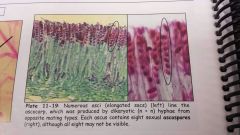
|
|
|
zygospores
|
sexual spores made by Rhizopus and others zygomycetes
|
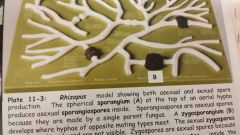
|
|
|
Basidium
|
a club shaped cell that produces 4 sexual basidiospores
|

|
|
|
Claviceps purpurea causes a disease called
|
ergot of rye
|
|
|
|
the stipe
|
the stalk of a mushroom that supports the pileous
it usually has an annulus |
|
|
|
the alkaloid toxins of ergot affect the thalamus resulting in
|
mixing of senses called hallucinations
|
|
|
|
dikaryotic
|
n plus n hypae produced by the union of two opposite mating types
|
|
|
|
morels
|
above ground, as well as underground truffles are considered delicious ascomycetes
|
|
|
|
Rhizopus asexual spores
|
called sporangiospores in aerial sporangia
|
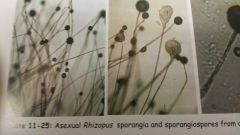
|
|
|
corn smut
|
a disease caused by a parasitic Basidiomycete with haustoria that penetrate into the corn kernels
the Kerala enlarge and finally bust open to release spores |
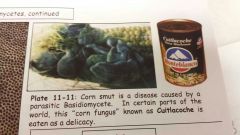
|
|
|
zygospores, Ascospores, and basidiosporez are all examples
|
sexual spores
|
|
|
|
fungal spores
|
haploid, one set off unpaired chromosomes
|
|
|
|
chlamypospores
|
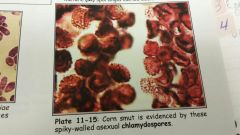
round thick walled asexual spores made by cells of hyphae if some fungi, spiked walls for attachment
|
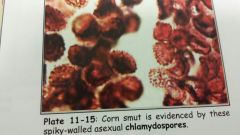
|
|
|
hyphae
|
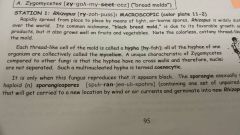
single filament of a mold, coenocytic or septate
|
|
|
|
tinea
|
indicates some ringworm infection
|
|
|
|
arthrospores chlamydospores sporangiospores conidiospores and blastospores are all
|
asexual
|
|
|
|
histoplasmosis
|
a systematic fungal infection of the lungs from breathing in spores made by fungi on bat or bird droppings
|
|
|
|
the alkaloid toxins of ergot affect the
|
thalamus = hallucinations
|
|
|
|
what is the cell wall of hypha composed of
|
polysaccharide chitlin
|
|
|
|
Ascospores are
|
haploid
|
|
|
|
single celled fungi are commonly called
|
yeast
|
|
|
|
refers to ringworm infection if fingernails out toes
|
Tinea ungium
|
|
|
|
zygomycetes
|
fungi that produce sexual zygospores and asexual sporangiospores
|
|
|
|
deuteromycetes
|
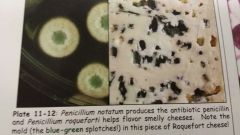
fungi nicknamed fungi imperfecti because they do not make sexual spores
|
|
|
|
what kind if troph are fungi
|
absorptive chemoheterotroph because they release digestive enzymes into their foods then take in pre digested nutrients
|
|
|
|
Pileus
|
the cap of the mushroom
|
|
|
|
a circle of mushrooms that grows above ground overnight is called a
|
fairy ring
|
|
|
|
spores
|
haploid reproductive cells produced by fungi
|
|
|
|
Basidiomycete
|
fungi that produce sexual basidiospores and asexual chlamydospores or arthrospores
|
|
|
|
mycosis
|
any disease produced by fungi
|
|
|
|
zygomycetes
|
reduce sexual spores inside a large thick walled structure called a zygosporangium
|
|
|
|
entire reproductive structure commonly called a mushroom is scientifically known as a
|
Basidiocarp
|
|
|
|
how is dispersal to an new environment possible
|
fungus has spores that are dust like particles
|
|
|
|
basidiospores
|
sexual spores made by mushrooms smuts rust puffballs and shelf fungi
|
|
|
|
histoplasmosis
|
systemic fungal infection of the lungs from breathing and spores made by fungi grow in upon birds or bat dropping
|
|
|
|
ascus
|
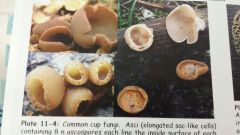
sac that contains 8 Ascospores
|
|
|
|
yeast reproduce asexually by
|
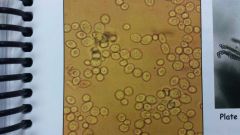
budding
|
|
|
|
what kind of fermentation do yeast under go
|
alcohol fermentation crucial to both the baking and the brewing industry
|
|
|
|
dimorphism
|
reverse the two forms of growth observe in many fungal pathogen at 37 degrees Celsius. yEast like
but at 25 degrees Celsius theyre mold like |
|
|
|
mycelium
|
a massive hyphae making up the body of a mold
|
|
|
|
offensive spores are haploid containing one set of
|
unpaired chromosomes
|
|
|
|
arthrospores
|
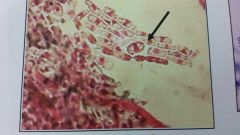
barrel-shaped asexual spores made by fragmentation of Septate hypha of some fungi
|
|
|
|
how many sexual ascospores are in an ascus
|
8
|
|
|
|
wheat rust
|
a disease caused by a parasitic Basidiomycete
reddish orange spores are produced in lesions of stems and leaves |
|
|
|
puffball
|
dry brittle basidiocarps that rupture to release spores when mature
|
|
|
|
Ascocarp
|
a cup shaped structure that produces ascospores an asci along its upper surface
|
|
|
|
both conidiospores and blastospores are produced by
|

budding
|
|
|
|
all fungal spores are
|
haploid containing one set of unpaired chromosomes
|
|
|
|
dermatomycosis
|
cutaneous fungal skin infection such as ringworm
|
|
|
|
these grow up right from horizontal vegetative hyphae
|
aerial reproductive hyphae
|
|
|
|
Haustoria
|
penetrating haphae of parasitic fungi
|
|
|
|
how many sexual basidiospores produced on each basidium
|
4
|
|
|
|
sporangium
|

enclosed structure that produces asexual sporangiospores
|
|
|
|
ringworm of the body
|
tinea corporus
|
|
|
|
Saccharomyces
|
a very economically important ascomycete
the baking and brewing industries depend on me because alcohol fermentation |
|
|
|
Lamellae
|
the gills of a mushroom that support the basdia bearing basidiospores
|
|
|
|
Penicillium
|
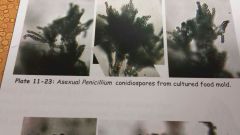
a deuteromycete and the source of the first major antibiotic discovered by Alexander Fleming
|
|
|
|
yeast buds are also referred to as asexual spores called
|
blastospores
|
|
|
|
aseomycetes
|
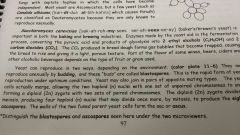
fungi that produce sexual ascospores or asexual conidiospores or blastospores
|
|
|
|
are fungal cells eukaryotic or prokaryotic
|
eukaryotic because they have a true membrane bound nucleus and many membrane-bound organelles
|
|
|
|
ringworm of the head and scalp
|
tinea capitis
|
|
|
|
an edible basidiocarp composed of a stipe and pileus bearing Lamellae is commonly called a
|
mushroom
|
|
|
|
the scar on the stipe of a mushroom left by the expanding Pileus is called the
|
Annulus
|
|
|
|
grows horizontally on the food surface obtaining nutrients for the fungus
|
vegetative hyphae
|
|
|
|
ascomycetes and Basidiomycetes have blank hyphae divided by cross walls
|
septate
|
|
|
|
Dermatomycoses such as tinea are caused by fungi that produces enzyme
|
Karetinase
|
|
|
|
conidiospores
|
asexual spores that butt off the tips of aerial hyphae made by Penicillium
|
|
|
|
coenocytic hyphae
|
are not divided by cross walls are there for multinucleated
|
|
|
|
thrush
|
an example of opportunistic mycosis caused by an organism that is usually harmless but that may take advantage of immune compromised host or following broad spectrum antibiotic use
|
|
|
|
the genius of the common black bread mold
|
Rhizopus
|
|
|
|
claviceps
|
ascomycete plant pathogen of grains such as Rye causing ergot if ingested produce hallucinations and were the original source of LSD
|
|
|
|
ringworm infection called jock itch
|
tinea cruris
|
|
|
|
an opportunistic pathogenic yeast that causes thrust
|
Canadida
|
|
|
|
shelf fungi
|
also called bracket fungi basidiomycetes that grow horizontally out from fences logs, etc.
|
|
|
|
athlete's foot
|
tinea pedis
|
|
|
|
two haploid nuclei from a dikaryotic hypha fuse use a diploid zygote is formed with blank sets of paired chromosomes
|
2
|
|

